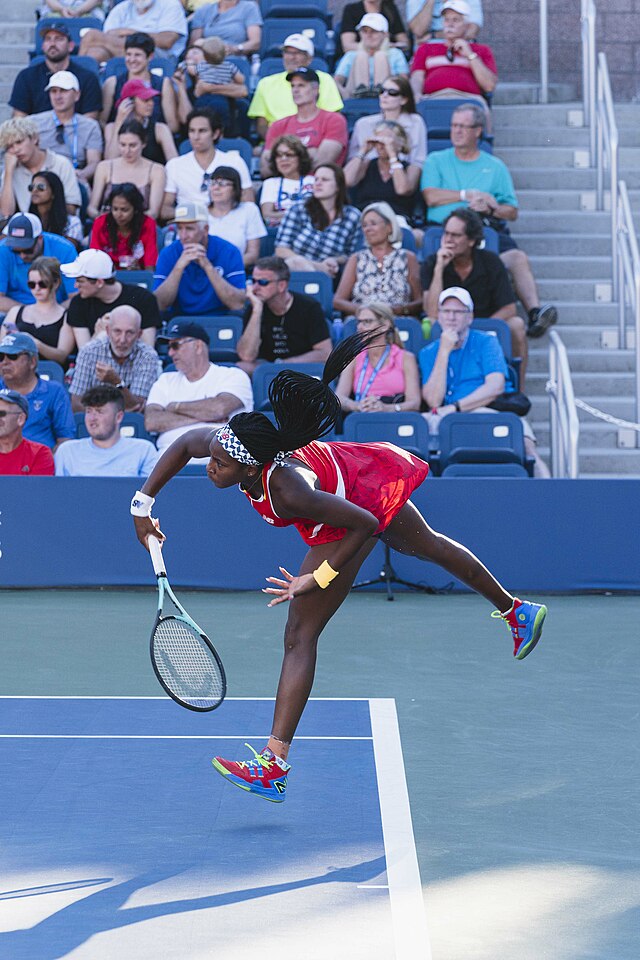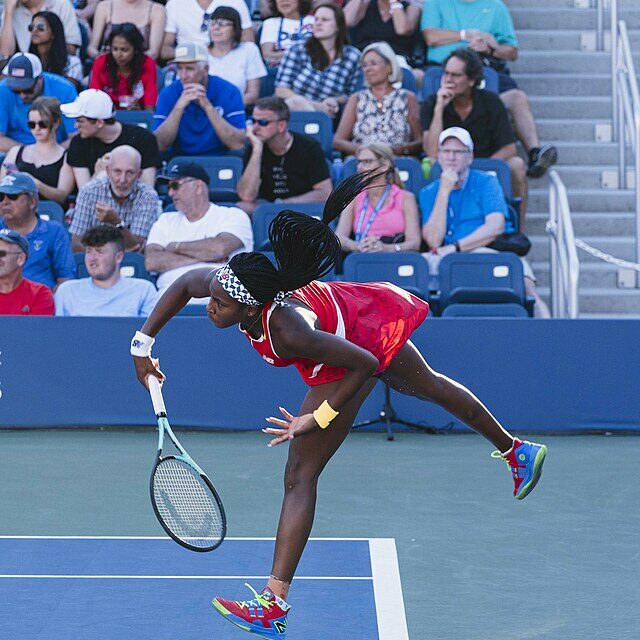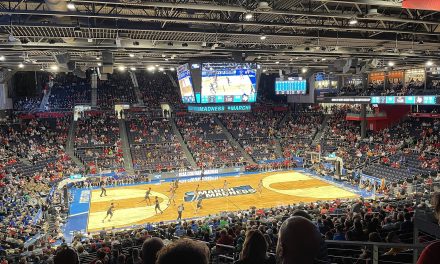
Coco Gauff serves at the US Open on Sept. 1, 2022. (Courtesy of Wikimedia Commons/All-Pro Reels)
The whole US Open Tennis Championships (US Open) was almost operatic. On one side, we have a young star, Coco Gauff, breaking through and winning her first Grand Slam title in front of her home crowd. On the other, Novak Djokovic continues his complete and utter dominance.
Djokovic takes 24th Grand Slam, ties Margaret Court
The men’s bracket was filled with stories, including multiple American ones. Three American men — Taylor Fritz, Frances Tiafoe and Ben Shelton — made the quarterfinals for the first time since 2005. Shelton defeated No. 13 Tommy Paul in the previous round, notably hitting the fastest serve in tournament history at 149 mph twice. Unfortunately, Djokovic walked over Fritz and then defeated Shelton in the semifinals.
Nonetheless, Shelton’s performance at the US Open was a good way to end his rather underwhelming year. Despite reaching the semifinals, he finished with a 17-21 record in 2023. Shelton had not won back-to-back matches since his quarterfinal run at the 2022 Australian Open. As a result of his showing in New York, Shelton became No. 19, earning the first top 2o ranking of his career.
Jannik Sinner lost in Round 4 in a marathon match to Alexander Zverev. The match, which lasted four hours and 41 minutes, consisted of five sets and ended at 1:30 a.m. Zverev faced Carlos Alcaraz in the quarterfinals, but it seemed that the nearly five-hour match only 36 hours prior had taken everything out of him, as Zverev lost in straight sets (6-3, 6-2, 6-4).
High-ranking players like Holger Rune (No. 4) and Casper Ruud (was No.5, now No. 9), and three-time Grand Slam champion Andy Murray were all shockingly eliminated by Round 2. Rune and Ruud were expected to make deep runs, as Rune made the quarters at both Roland-Garros and Wimbledon this year, and Ruud was the runner-up at both this year’s French Open and last year’s US Open.
Daniil Medvedev defeated former No. 1 Alcaraz in the semifinals, so unfortunately fans did not get to see the dream rematch of this year’s Wimbledon and Cincinnati Open finals, which Alcaraz and Djokovic split. If Djokovic had won at Wimbledon this year, he would have become the first man since the Open Era began in 1968 to win all four majors in the same calendar year. This is the third time that Djokovic has won three majors in one year.
The final lasted “only” three hours and 16 minutes, and Djokovic was able to win in straight sets (6-3, 7-6(5), 6-3), paling in comparison to the Wimbledon final earlier this year, which lasted nearly five hours. Medvedev and Djokovic faced each other in the 2021 US Open final, where Medvedev won relatively easily (6-4, 6-4, 6-4). This year, Medvedev was not so lucky.
There was nothing particularly flashy about Djokovic’s performance. He just meticulously deconstructed Medvedev’s game. Djokovic is a robot on the court — he rarely makes a mistake — and this mechanical perfection is what propelled him to the title.
Medvedev served to open the match, but Djokovic immediately broke and cruised easily through the first set. Because of both players’ strong ground games, grueling rallies defined the first two sets. In fact, the first point of the match was a 19-shot rally, followed almost immediately by a 23-shot rally. Djokovic won both points.
A staggering 25% of points were over nine shots. The average rally length for the match was 6.3 shots. For reference, both of the semifinal matches averaged closer to four shots.
The second set was really the story of the match. It lasted an epic 104 minutes as both players traded punches. Medvedev cleaned up his serve and began landing 69% of his first serves. The long rallies only got more difficult in the second set. They eventually began to take a toll on Djokovic; on several occasions he was unable to finish out a point or would collapse to his knees right after the point was finished due to pure exhaustion. Somehow, Djokovic managed to hold all of his serves and force the set into a tie break, where he would pull off even more magic.
Medvedev broke serve early, leading 3-1 before losing three consecutive points and then losing the tiebreak, 7-5.
Having just taken a two-set lead, a revitalized Djokovic came out and dominated in the third set. He broke serve twice, held his own and won the set 6-3 in 44 minutes, capturing his 24th single’s Grand Slam title and reclaiming his spot as the No. 1 ranked player in the world, which he has now held for a record-shattering total of 390 weeks.
“[Djokovic] was kind of better than me, and there’s not much to say,” Medvedev said in the post-match press conference. “[In the] second, if I had won it, maybe it would’ve been a different game.”
One of the problems that Medvedev faced — and it has been for some time, see his semifinal at Wimbledon against Alcaraz — was Djokovic’s serve and volley. The reason is that Medvedev has become known for his incredibly deep return position. While most players return service from about six or eight feet behind the baseline, Medvedev often stands about 15 or 20 feet behind the baseline, making it much harder to recover a volley because he has so much more ground to cover. Djokovic attempted the serve and volley 22 times and won 20 of them. This was especially effective towards the end of the match, when Djokovic was able to end points quickly and was thus able to avoid the long rallies that had tired him out.
After his victory, an emotional Djokovic made his way through the stands, filled with thousands of screaming New Yorkers, to his box. Before hugging and kissing his wife and children, Djokovic had a passionate embrace with none other than Matthew McConaughey.
Moments after the men’s final ended, Medvedev stepped up to the microphone during the trophy presentation, looked at Djokovic and asked “first of all, what are you still doing here?”
We may never know the answer, but it probably doesn’t matter. Either way, with the win over Medvedev to capture the 2023 US Open title, Djokovic cemented himself as, indisputably, the greatest male tennis player to ever touch a racket.
Atlanta native becomes youngest women’s US Open winner
Gauff defeated Aryna Sabalenka in three sets (2-6, 6-3, 6-2) to capture her first Grand Slam title in her first appearance in a US Open final.
The 2023 season was unpredictable for Gauff. She made the quarterfinals at Indian Wells but lost in the Round of 32 at the Miami Open. Gauff recovered by making the quarterfinals in the French Open but then lost in the Round of 128 at Wimbledon. After the shocking loss at Wimbledon, Gauff admitted that what she was doing “wasn’t enough” and that she needed to make changes.
In late July, Gauff hired Brad Gilbert as her head coach. Gilbert boasts a successful career, having coached prominent players such as Andre Agassi, Andy Roddick and Andy Murray.
In August, changes in Gauff’s game were already taking place. She began the month by winning the Mubadala Citi DC Open, a Women’s Tennis Association (WTA) 500 tournament. The next week she made the quarterfinals in Montreal at the National Bank Open, a WTA 1000 tournament. She followed that up by winning the largest US Open warm-up tournament, the Cincinnati Open.
Gauff continued her momentum into New York. It wasn’t all easy though; she played three three-set matches on her road to victory and also had to defeat top-ranked players like Karolína Muchová and Jeļena Ostapenko.
Early in the match, Sabalenka’s incredible racket power overwhelmed Gauff. Sabalenka’s average first serve speed sits around 107 miles per hour. The match was ultimately a battle of opposites, as Sabalenka is one of the best offensive players in women’s tennis, while Gauff is probably one of the best defensive players.
Sabalenka attacked Gauff’s forehand every chance she got, and it worked. Gauff had 12 errors off of forehands in the first set and had her serve broken three times, losing the set 2-6 in 4o minutes. Gauff continued to struggle early in the second set before she was able to get the crowd involved.
Sabalenka was able to keep the crowd quiet early on, but as Gauff began to warm up and eventually break Sabalenka’s serve, there was no going back. It was this momentum of 20,000 fans at Arthur Ashe Stadium that pushed the match to a deciding third set.
After the overwhelming display of Sabalenka’s power in the first set, Gauff’s agility began to control the match. She started to put pressure on Sabalenka, who had 16 errors in the closing set. Gauff’s improved forehand also allowed her to dominate in the third set.
However disoriented Sabalenka’s play made Gauff in the first set, Gauff — in conjunction with the 20,000 fiery match attendees — had double the effect in the third. Gauff landed 85% of her first serves and broke Sabalenka’s serve three times; she had taken complete control of the match by the last set. In the first set, Sabalenka forced the match to be played from the baseline, and Gauff averaged around 50 feet traveled per point. In the third set, she traveled over 70 feet per point, reflecting the speedy, defensive play style that she thrives in.
Despite the loss, Sabalenka will be crowned as the new world No. 1 next week. She made the semifinals at all four Grand Slams and won the Australian Open.
Regardless of her inconsistent season, Gauff has a bright future ahead of her. She draws comparisons to Serena Williams, largely due to her success and the skills she has shown at her young age. Gauff is the youngest to win the US Open since Williams in 1999. The Grand Slam title boosted Gauff to No. 3 in the world, setting up what looks to be an incredibly successful decade of tennis from the young American.
Daniel Rosen (he/him) is from Atlanta, Georgia, majoring in film and media. He is part of Emory's improv comedy troupe, Rathskellar. Rosen spends his free time hoping the Atlanta Hawks will finally be good this year, playing tennis and trying to watch every movie.




